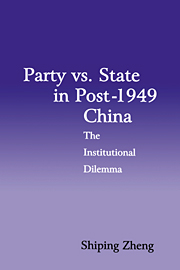Book contents
- Frontmatter
- Contents
- List of Tables
- Acknowledgments
- List of Abbreviations
- Part I Introduction
- Part II State-building under a Revolutionary Party: The Mao Zedong Era
- 3 Revolution, Laws, and Party
- 4 Party Leadership and State Administration
- 5 Army-Building and Revolutionary Politics
- 6 Politics of Campaigns: The Cultural Revolution
- Part III State-building under a Reformist Party: The Deng Xiaoping Era
- Conclusions
- Appendix A CCP Membership Changes, 1921–96
- Appendix B Campaigns in China, 1950–89
- Bibliography
- Index
5 - Army-Building and Revolutionary Politics
Published online by Cambridge University Press: 23 September 2009
- Frontmatter
- Contents
- List of Tables
- Acknowledgments
- List of Abbreviations
- Part I Introduction
- Part II State-building under a Revolutionary Party: The Mao Zedong Era
- 3 Revolution, Laws, and Party
- 4 Party Leadership and State Administration
- 5 Army-Building and Revolutionary Politics
- 6 Politics of Campaigns: The Cultural Revolution
- Part III State-building under a Reformist Party: The Deng Xiaoping Era
- Conclusions
- Appendix A CCP Membership Changes, 1921–96
- Appendix B Campaigns in China, 1950–89
- Bibliography
- Index
Summary
THE founding of the People's Republic of China in 1949 signified a fundamental change in the status of the People's Liberation Army (PLA). From now on, the PLA was no longer a group of rebel or guerrilla forces scattering all over the country and only loosely coordinated by the Communist Party leaders hiding in isolated areas. It was a national standing army under a new central government. Its main mission was no longer harassing the official troops, attacking the government facilities, and sabotaging the public order. As the pillar of the new political order, the PLA was commissioned to defend the country and safeguard the national interests. As such, the PLA was to become more like any official army in other countries, and it would have to meet the standards of such an official army. This chapter examines the PLA's modernization programs in the 1950s and the emerging tensions between building a modern standing army and maintaining the traditional control by the revolutionary party. It analyzes the intricate historical and structural linkage between the Party and the army and underscores the inherent danger of the PLA's political role.
- Type
- Chapter
- Information
- Party vs. State in Post-1949 ChinaThe Institutional Dilemma, pp. 106 - 131Publisher: Cambridge University PressPrint publication year: 1997



